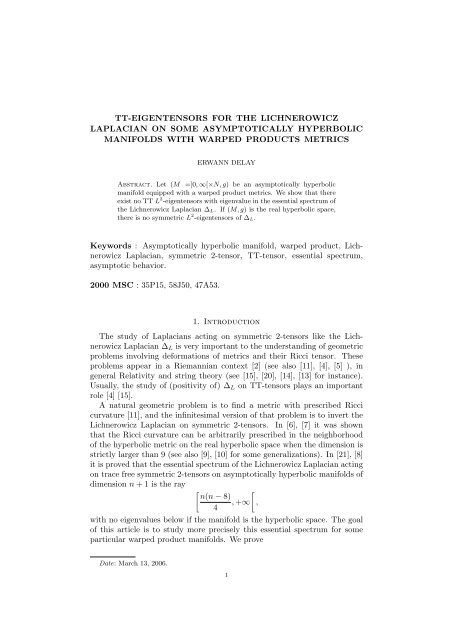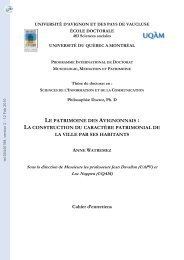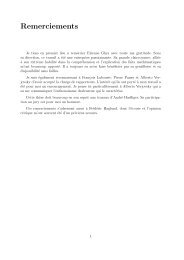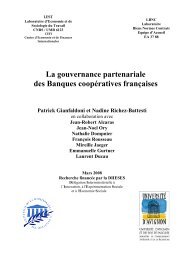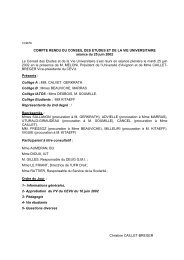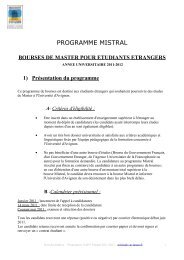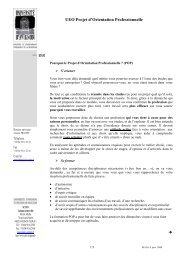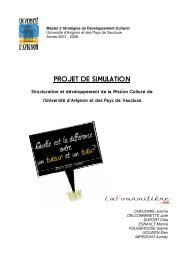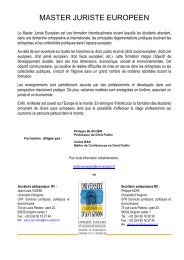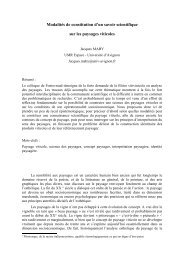TT-EIGENTENSORS FOR THE LICHNEROWICZ LAPLACIAN ON ...
TT-EIGENTENSORS FOR THE LICHNEROWICZ LAPLACIAN ON ...
TT-EIGENTENSORS FOR THE LICHNEROWICZ LAPLACIAN ON ...
You also want an ePaper? Increase the reach of your titles
YUMPU automatically turns print PDFs into web optimized ePapers that Google loves.
<strong>TT</strong>-<strong>EIGENTENSORS</strong> <strong>FOR</strong> <strong>THE</strong> <strong>LICHNEROWICZ</strong><br />
<strong>LAPLACIAN</strong> <strong>ON</strong> SOME ASYMPTOTICALLY HYPERBOLIC<br />
MANIFOLDS WITH WARPED PRODUCTS METRICS<br />
ERWANN DELAY<br />
Abstract. Let (M =]0, ∞[×N, g) be an asymptotically hyperbolic<br />
manifold equipped with a warped product metrics. We show that there<br />
exist no <strong>TT</strong> L 2 -eigentensors with eigenvalue in the essential spectrum of<br />
the Lichnerowicz Laplacian ∆ L. If (M, g) is the real hyperbolic space,<br />
there is no symmetric L 2 -eigentensors of ∆ L.<br />
Keywords : Asymptotically hyperbolic manifold, warped product, Lichnerowicz<br />
Laplacian, symmetric 2-tensor, <strong>TT</strong>-tensor, essential spectrum,<br />
asymptotic behavior.<br />
2000 MSC : 35P15, 58J50, 47A53.<br />
1. Introduction<br />
The study of Laplacians acting on symmetric 2-tensors like the Lichnerowicz<br />
Laplacian ∆ L is very important to the understanding of geometric<br />
problems involving deformations of metrics and their Ricci tensor. These<br />
problems appear in a Riemannian context [2] (see also [11], [4], [5] ), in<br />
general Relativity and string theory (see [15], [20], [14], [13] for instance).<br />
Usually, the study of (positivity of) ∆ L on <strong>TT</strong>-tensors plays an important<br />
role [4] [15].<br />
A natural geometric problem is to find a metric with prescribed Ricci<br />
curvature [11], and the infinitesimal version of that problem is to invert the<br />
Lichnerowicz Laplacian on symmetric 2-tensors. In [6], [7] it was shown<br />
that the Ricci curvature can be arbitrarily prescribed in the neighborhood<br />
of the hyperbolic metric on the real hyperbolic space when the dimension is<br />
strictly larger than 9 (see also [9], [10] for some generalizations). In [21], [8]<br />
it is proved that the essential spectrum of the Lichnerowicz Laplacian acting<br />
on trace free symmetric 2-tensors on asymptotically hyperbolic manifolds of<br />
dimension n + 1 is the ray<br />
[ [<br />
n(n − 8)<br />
, +∞ ,<br />
4<br />
with no eigenvalues below if the manifold is the hyperbolic space. The goal<br />
of this article is to study more precisely this essential spectrum for some<br />
particular warped product manifolds. We prove<br />
Date: March 13, 2006.<br />
1
2 E. DELAY<br />
Theorem. For n ≥ 2, let us consider (N, ĝ) be an n-dimensionnal<br />
compact Einstein manifold. Let M =]0, +∞[×N equipped with an asymptotically<br />
hyperbolic metric g = dr 2 +f 2 (r)ĝ (as in section 2). Then there are<br />
no L 2 <strong>TT</strong>-eigentensors of the Lichnerowicz Laplacian ∆ L with eigenvalue<br />
embedded in the essential spectrum. For the real hyperbolic space, there are<br />
no L 2 eigentensors of ∆ L .<br />
As this result concern only embedded eigenvalues in an essential spectrum<br />
and it is well know that the essential spectrum is characterized at infinity,<br />
the manifold can be replaced by any manifold which is of the form given<br />
here only outside a compact set.<br />
This theorem is a consequence of the corollary 3.6 and the theorem 6.2.<br />
Note that this result can easily be adapted to Laplacians on symmetric<br />
covariant 2-tensors of the form ∇ ∗ ∇+ curvatures terms. The complete proof<br />
is in fact given for the rough Laplacian.<br />
Our proof, as the one used by Donnelly [12] for forms on H n+1 , consist<br />
to use a Hodge type decomposition theorem for symmetric 2-tensors on a<br />
compact Einstein manifold N (see also [19] for a similar decomposition on<br />
AdS where N = S n ). This decomposition gives a separation of variable<br />
technique to the equations studied here. The problem is then reduced to<br />
asymptotic integration for ordinary differential equations of the form<br />
y ′′ (r) + (α 2 + O(e −εr ))y(r) = O(e −εr ), α ≥ 0, ε > 0.<br />
The asymptotic behaviour of the solutions to these equations and the L 2<br />
condition will give the result.<br />
As discussed with R. Mazzeo, it is certainly possible to generalize the<br />
result to certain conformally compact manifolds by carefully constructing a<br />
parametrix for the Lichnerowicz Laplacian as he did in [23] for the Hodge<br />
Laplacian. The proof given here has the merit to be purely geometric and<br />
easily tractable.<br />
When the dimension n + 1 is less than or equal to 9, 0 is in the essential<br />
spectrum of ∆ L . The result given here proves that ∆ L stays injective (in L 2 )<br />
when n + 1 ≥ 3, so its image is not closed (but dense) in L 2 . In particular<br />
∆ L is not surjective. This suggests it might be possible to find some (at<br />
least infinitesimally) prohibited directions to prescribe the Ricci curvature<br />
near this space.<br />
The action of the Lichnerowicz Laplacian in the conformal direction corresponds<br />
to the action of the Laplacian on functions. Since we know that<br />
spectrum (see [23] for instance), we are only interested here about the trace<br />
free direction.<br />
This article is organized as follows : first in section 2, we will introduce<br />
all the objects we need along the paper. In section 3 we will see that on the<br />
real hyperbolic space any L 2 eigentensor must be a <strong>TT</strong>-tensor. In section 4<br />
we compute the components of the Laplacian of a <strong>TT</strong>-tensor for a warped<br />
product metric. In section 5, we detail the Hodge type decomposition that<br />
we will need in the proof of the main theorem. In section 6 we give the<br />
proof of the main theorem. The appendix, section 7, recall some results of<br />
asymptotic integration for ordinary differential equations.
<strong>TT</strong>-<strong>EIGENTENSORS</strong> <strong>ON</strong> SOME AH MANIFOLDS 3<br />
Acknowledgments. I am grateful to G. Carron, P. T. Chruściel, B. Colbois<br />
and R. Mazzeo for useful conversations, to Ph. Delanoë and F. Gautero for their<br />
comments on the original manuscript.<br />
2. Definitions, notations and conventions<br />
Let n ≥ 2 and let (N, ĝ) be an n dimensional riemannian manifold. The<br />
riemannian manifolds we are studying throughout the paper after the section<br />
3 are of the form M =]0, +∞[×N endowed with a warped product metric :<br />
g = dr 2 + f 2 (r)ĝ = dr 2 + f 2 (r)dθ 2 ,<br />
where f is a smooth positive function on ]0, ∞[. We will say that (M, g) is<br />
an asymptotically hyperbolic manifold if there exist ε > 0 such that, when<br />
r goes to infinity,<br />
( )<br />
1<br />
f(r), f ′ (r), f ′′ (r) = e r 2 + O(e−εr ) .<br />
The basic example studied here is when f = sinh and (N, ĝ) is the standard<br />
n-dimensional sphere endowed with its canonical metric, so (M, g) is the<br />
real hyperbolic space (minus a point). There are also interesting case when<br />
(N, ĝ) is Einstein with Ric(ĝ) = κ(n − 1)ĝ and f(r) = 1 2 (er − κe −r ) so<br />
Ric(g) = −ng.<br />
We denote by ∇ the Levi-Civita connexion of g and by Riem(g), Ric(g)<br />
respectively the Riemannian sectional and the Ricci curvature of g.<br />
We denote by T p the set of rank p covariant tensors. When p = 2, we<br />
denote by S 2 the subset of symmetric tensor which splits in G ⊕ ˚S 2 where G is<br />
the set of g-conformal tensors and ˚S 2 the set of trace-free tensor (relatively<br />
to g). We observe the summation convention, and we use g ij and its inverse<br />
g ij to lower or raise indices.<br />
The Laplacian is defined as<br />
△ = −tr∇ 2 = ∇ ∗ ∇,<br />
where ∇ ∗ is the L 2 formal adjoint of ∇. The Lichnerowicz Laplacian acting<br />
on symmetric covariant 2-tensors is<br />
where<br />
△ L = △ + 2(Ric − Riem),<br />
(Ric u) ij = 1 2 [Ric(g) iku k j + Ric(g) jk u k i ],<br />
and<br />
(Riem u) ij = Riem(g) ikjl u kl .<br />
For u a covariant 2-tensorfield on M we define the divergence of u by<br />
(divu) i = −∇ j u ji .<br />
For ω, a one form on M , we define its divergence<br />
d ∗ ω = −∇ i ω i ,<br />
the symmetric part of its covariant derivative :<br />
(Lω) ij = 1 2 (∇ iω j + ∇ j ω i ),
4 E. DELAY<br />
(note that L ∗ = div) and the trace free part of that last tensor :<br />
(˚Lω) ij = 1 2 (∇ iω j + ∇ j ω i ) + 1<br />
n + 1 d∗ ωg ij .<br />
The well known [2] weitzenböck formula for the Hodge-De Rham Laplacian<br />
on 1-forms reads<br />
∆ H ω i = ∇ ∗ ∇ω i + Ric(g) ik ω k .<br />
All quantities relative to ĝ will have a hat or will be indexed by ĝ (∇ bg , div bg ,<br />
d bg , ̂∆ L ,...)<br />
A <strong>TT</strong>-tensor (Transverse Traceless tensor) is by definition a symmetric<br />
divergence free and trace free covariant 2-tensor .<br />
L 2 denotes the usual Hilbert space of functions or tensors with the product<br />
(resp. norm)<br />
∫<br />
∫<br />
〈u, v〉 L 2 = 〈u, v〉dµ g (resp. |u| L 2 = ( |u| 2 dµ g ) 1 2 ),<br />
M<br />
M<br />
where 〈u, v〉 (resp. |u|) is the usual product (resp. norm) of functions or<br />
tensors relative to g, and the measure dµ g is the usual measure relative to<br />
g (we will omit the term dµ g ).<br />
3. Commutators of some natural operators<br />
We will study the commutator of the Laplacian with the divergence operator<br />
in order to apply the result for an eigentensor. We also study the<br />
commutator of the Laplacian with the Killing operator L needed in section<br />
5. For further references, we will be as general as possible, in particular the<br />
manifold M is not necessarily a product. We first begin with the lemma:<br />
Lemma 3.1. On a Riemannian manifold (M, g) with Levi-Civita connexion<br />
∇, for all symmetric 2-tensor field u, we have<br />
∇ i ∇ k ∇ k u ij = ∇ k ∇ k ∇ i u ij + R il ∇ l u ij + 2Rj<br />
l ki<br />
∇k u il + ∇ k R p k u pj + ∇ k R p i jk<br />
u ip<br />
= ∇ k ∇ k ∇ i u ij + R il ∇ l u ij − 2R j lki ∇ k u il + 1 2 ∇p Ru pj + (∇ p R ij − ∇ j R ip )u ip .<br />
Proof. For a covariant 3-tensor field T on M, we have<br />
∇ p ∇ q T kij − ∇ q ∇ p T kij = R l kqp T lij + R l iqpT klj + R l jqpT kil .<br />
Contracting this equality with g ip g qk , we obtain<br />
(3.1) ∇ i ∇ k T kij − ∇ k ∇ i T kij = R l jki<br />
Tkil .<br />
For a covariant 2-tensor field u on M, we have<br />
∇ m ∇ k u ij − ∇ k ∇ m u ij = R p ikm u pj + R p jkm u ip.<br />
Contracting this equality with g im , we obtain<br />
∇ i ∇ k u ij − ∇ k ∇ i u ij = R p k u pj + R p jki u ip .<br />
From this last equality, we obtain<br />
(3.2)<br />
∇ k ∇ i ∇ k u ij − ∇ k ∇ k ∇ i u ij = ∇ k R p k u pj + ∇ k R p i jk<br />
u ip + R p k ∇k u pj + R p i jk<br />
∇ k u ip .
<strong>TT</strong>-<strong>EIGENTENSORS</strong> <strong>ON</strong> SOME AH MANIFOLDS 5<br />
Taking T kij = ∇ k u ij in equation 3.1 and combining with equation 3.2, we<br />
get the annonced equality. The equality in the lemma is due to Bianchi<br />
identities.<br />
□<br />
Remark. The formula in lemma 3.1 is much simpler when the curvature<br />
is harmonic (∇ k R kijl = 0) or equivalently when Ric(g) is a Codazzi tensor<br />
(∇ k R ij − ∇ i R kj = 0) and (or) the tensor u satisfy an equality of the form<br />
∇ k u ij − ∇ i u kj + f∇ j u ik = 0 (f is any real function).<br />
Corollary 3.2. On a Riemannian manifold (M, g) with Levi-Civita connexion<br />
∇, we have<br />
div ◦ ∆ L = ∆ H ◦ div − D Ric,<br />
where (D Ric u) j = (∇ p R ij − ∇ j R ip − ∇ i R jp )u ip = (∇ j R ik )u ik .<br />
Proof. From lemma 3.1, we have<br />
∇ i (∇ k ∇ k u ij − R ik u k j − R jk u k i + 2R jlik u kl ) = ∇ k ∇ k ∇ i u ij − R l j∇ i u il<br />
Also, we have the<br />
+(∇ p R ij − ∇ j R ip − ∇ i R jp )u ip<br />
= ∇ k ∇ k ∇ i u ij − R l j∇ i u il<br />
−(∇ j R ip )u ip .<br />
Lemma 3.3. On a Riemannian manifold with Levi-Civita connexion ∇, we<br />
have<br />
∆ L ◦ L = L ◦ ∆ H + D Ric,<br />
where (D Ric ξ) ij = (∇ p R ij − ∇ j R ip − ∇ i R jp )ξ p .<br />
Proof. A straightforward computation gives<br />
∇ k ∇ k ∇ i ξ j = ∇ i ∇ k ∇ k ξ j + R ik ∇ j ξ k − 2R ikjl ∇ k ξ l − (∇ k R ij − ∇ j R ik )ξ k .<br />
The result follows from the definitions of the Hodge and Lichnerowicz Laplacians.<br />
□<br />
In particular the Corollary 3.2 and Lemma 3.3 together give a theorem<br />
of Lichnerowicz ( [22] page 29)<br />
Theorem 3.4. On a Riemannian manifold (M, g) with parallel Ricci curvature,<br />
we have<br />
div ◦ ∆ L = ∆ H ◦ div ,<br />
and<br />
∆ L ◦ L = L ◦ ∆ H .<br />
Remark. The condition ∇ p R ij − ∇ j R ip − ∇ i R jp = 0 is equivalent to the<br />
parallel Ricci curvature condition.<br />
Corollary 3.5. On a (n+1)-dimensional Riemannian manifold (M, g) with<br />
Levi-Civita connexion ∇ and constant sectional curvature K, for all trace<br />
free symmetric 2-tensor fields u, we have<br />
∇ i ∇ k ∇ k u ij = ∇ k ∇ k ∇ i u ij + (n + 2)K∇ i u ij ,<br />
□
6 E. DELAY<br />
or equivalently<br />
div ◦ ∆ = [∆ − (n + 2)K] ◦ div.<br />
Corollary 3.6. On the (n+1)-dimensional real hyperbolic space with n ≥ 2,<br />
any L 2 symmetric trace free eigentensor field is divergence free, and so is a<br />
<strong>TT</strong>-tensor.<br />
Proof. If u is an L 2 symmetric trace free eigentensor field on the real hyperbolic<br />
space, then div u is an L 2 eigenform, but from [12] (see also [23] for a<br />
generalization) this form must be trivial.<br />
□<br />
4. Components of the divergence and the Laplacian of a<br />
2-tensor<br />
We will compute the components of the divergence and Laplacian for a<br />
symmetric 2-tensor and adapt the result for the case of trace free tensor. In<br />
this section the riemannian manifold (N, ĝ) is not assumed to be Einstein.<br />
On M =]0, +∞[×N, we consider the metric<br />
g = dr 2 + f 2 (r)ĝ.<br />
The computation is given in local coordinates adapted to the character of<br />
M. We will use a local coordinate (x 1 , ..., x n ) = (x A ) on the manifold N<br />
and the coordinate (x 0 , x 1 , ..., x n ) = (r, x 1 , ..., x n ) = (x i ) on M. The indices<br />
with big letters are relative to the coordinate on N, for example<br />
g 00 = 1, g 0A = 0, g AB = f 2 ĝ AB .<br />
The prime in the calculation will denote derivative relative to r.<br />
The Christoffel’s symbol of g are<br />
Γ 0 00 = Γ C 00 = Γ 0 A0 = 0,<br />
Γ 0 AB = −ff ′ ĝ AB , Γ C A0 = f −1 f ′ δ A C , Γ C AB = ̂Γ C AB.<br />
If h is a covariant symmetric 2-tensor, we decompose<br />
(4.1) h = udr 2 + ξ ⊗ dr + dr ⊗ ξ + ĥ,<br />
where ĥ is the orthogonal projection of h on {r} × N, and ξ is a one form<br />
on {r} × N. In particular we have<br />
The covariant derivatives of h are<br />
∇ 0 h 00 = ∂ 0 h 00 = u ′ ,<br />
h 00 = u, h 0A = ξ A , h AB = ĥAB.<br />
∇ 0 h A0 = ∂ 0 h A0 − f −1 f ′ h A0 = ξ ′ A − f −1 f ′ ξ ′ A,<br />
∇ 0 h AB = ∂ 0 h AB − 2f −1 f ′ h AB = ĥ′ AB − 2f −1 f ′ ĥ AB ,<br />
∇ C h 00 = ∂ C h 00 − 2f −1 f ′ h C0 = d C u − 2f −1 f ′ ξ C ,<br />
∇ C h A0 = ̂∇ C h A0 + ff ′ ĝ AC h 00 − f −1 f ′ h AC = ̂∇ C ξ A + ff ′ ĝ AC u − f −1 f ′ ĥ AC ,<br />
∇ C h AB = ̂∇ C h AB + ff ′ (ĝ AC h 0B + ĝ CB h 0A ) = ̂∇ C ĥ AB + ff ′ (ĝ AC ξ B + ĝ CB ξ A ).<br />
In particular, we can compute the components of minus the divergence of h:<br />
∇ i h i0 = u ′ + nf −1 f ′ u − f −3 f ′ h A A + f −2 ̂∇A ξ A ,<br />
∇ i h iA = ξ ′ A + nf −1 f ′ ξ A + f −2 ̂∇B ĥ BA .
<strong>TT</strong>-<strong>EIGENTENSORS</strong> <strong>ON</strong> SOME AH MANIFOLDS 7<br />
If Tr g h = h 00 + f −2 h A A = u + f −2 Tr bg ĥ = 0, this yield<br />
We thus obtain the<br />
∇ i h i0 = u ′ + (n + 1)f −1 f ′ u + f −2 ̂∇A ξ A ,<br />
∇ i h iA = ξ ′ A + nf −1 f ′ ξ A + f −2 ̂∇B ĥ BA .<br />
Lemma 4.1. If h is a symmetric covariant 2-tensor decomposed as in 4.1<br />
then the components of its divergence are<br />
(divh) 0 = −(u ′ + nf −1 f ′ u − f −3 f ′ Tr bg ĥ − f −2 d ∗ bg ξ),<br />
(divh) A = −(ξ ′ + nf −1 f ′ ξ − f −2 div bg ĥ) A .<br />
If moreover h is trace free, the first component becomes<br />
(divh) 0 = −(u ′ + (n + 1)f −1 f ′ u − f −2 d ∗ bg ξ).<br />
In a similar way, we compute the components of the Laplacian of h. After<br />
a straightforward calculation we obtain the following Lemma<br />
Lemma 4.2. Let h be a trace free covariant symmetric 2-tensor decomposed<br />
as is 4.1. The components of minus the Laplacian of h are<br />
∇ k ∇ k h 00 = u ′′ + nf −1 f ′ u ′ − 2(n + 1)f −2 (f ′ ) 2 u + f −2 ̂∇A ̂∇A u − 4f −3 f ′ ̂∇A ξ A ,<br />
∇ k ∇ k h A0 = ξ ′′ A + (n − 2)f −1 f ′ ξ ′ A − [(2n + 1)f −2 (f ′ ) 2 + f −1 f ′′ ]ξ A<br />
+f −2 ̂∇D ̂∇D ξ A − 2f −3 f ′ ̂∇D h AD + 2f −1 f ′ d A u,<br />
∇ k ∇ k h AB = ĥ′′ AB + (n − 4)f −1 f ′ ĥ ′ AB − [(2n − 4)f −2 (f ′ ) 2 + 2f −1 f ′′ ]ĥAB<br />
+f −2 ̂∇D ̂∇D ĥ AB + 2f −1 f ′ ( ̂∇ A ξ B + ̂∇ B ξ A ) + (f ′ ) 2 ĝ AB u.<br />
In particular, if h is divergence free,<br />
∇ k ∇ k h 00 = u ′′ + (n + 4)f −1 f ′ u ′ + 2(n + 1)f −2 (f ′ ) 2 u + f −2 ̂∇A ̂∇A u,<br />
∇ k ∇ k h A0 = ξ ′′ A + (n)f −1 f ′ ξ ′ A − [f −2 (f ′ ) 2 + f −1 f ′′ ]ξ A<br />
+f −2 ̂∇D ̂∇D ξ A + 2f −1 f ′ d A u,<br />
∇ k ∇ k h AB = ĥ′′ AB + (n − 4)f −1 f ′ ĥ ′ AB − [(2n − 4)f −2 (f ′ ) 2 + 2f −1 f ′′ ]ĥAB<br />
+f −2 ̂∇D ̂∇D ĥ AB + 2f −1 f ′ ( ̂∇ A ξ B + ̂∇ B ξ A ) + (f ′ ) 2 ĝ AB u.<br />
In order to study the action of the zero order terms of the Lichnerowicz<br />
Laplacian, we compute the curvatures of g. A straightforward computation<br />
shows that the non trivial components of the Riemann Christoffel curvature<br />
are<br />
R A 0B0 = −f −1 f ′′ δ A B,<br />
R 0 A0B = −ff ′′ ĝ AB ,<br />
R A BCD = ̂R A BCD − (f ′ ) 2 (ĝ BD δ A C − ĝ BC δ A D).<br />
Thus the non trivial components of the Ricci curvature are<br />
R 00 = −nf −1 f ′′ , R AB = ̂R AB − [ff ′′ + (n − 1)(f ′ ) 2 ]ĝ AB .
8 E. DELAY<br />
Then, the zero order terms that appear in the Lichnerowicz Laplacian are<br />
2(Riem h) 00 = −2f −3 f ′′ Tr bg ĥ = 2f −1 f ′′ u,<br />
2(Ric h) 00 = −2nf −1 f ′′ u,<br />
2(Riem h) 0A = 2f −1 f ′′ ξ A ,<br />
2(Ric h) 0A = f −2 ̂RC A ξ C − ((n + 1)f −1 f ′′ + (n − 1)f −2 (f ′ ) 2 )ξ A ,<br />
2(Riem h) AB = 2f −2 ̂RACBD ĥ AB + 2f −2 (f ′ ) 2 (ĥAB − Tr bg ĥ ĝ AB ) − 2ff ′′ uĝ AB ,<br />
= 2f −2 ̂RACBD ĥ AB + 2f −2 (f ′ ) 2 ĥ AB ,<br />
2(Ric h) AB = 2f −2 (Ric bg ĥ) AB − 2(f −1 f ′′ + (n − 1)f −2 (f ′ ) 2 )ĥAB.<br />
Lemma 4.3. Let h be a trace free covariant symmetric 2-tensor decomposed<br />
as is 4.1. The components of the Lichnerowicz Laplacian of h are<br />
∆ L h 00 = −u ′′ − nf −1 f ′ u ′ − f −2 ̂∇A ̂∇A u + 4f −3 f ′ ̂∇A ξ A ,<br />
∆ L h A0 = −ξ ′′ A − (n − 2)f −1 f ′ ξ ′ A + [(3n + 4)f −2 (f ′ ) 2 + nf −1 f ′′ ]ξ A<br />
−f −2 ( ̂∇ D ̂∇D ξ A − ̂R C Aξ C ) + 2f −3 f ′ ̂∇D h AD − 2f −1 f ′ d A u,<br />
∆ L h AB = −ĥ′′ AB − (n − 4)f −1 f ′ ĥ ′ AB − 4f −2 (f ′ ) 2 ĥ AB<br />
+f −2 ̂∆L ĥ AB − 2f −1 f ′ ( ̂∇ A ξ B + ̂∇ B ξ A ) − (f ′ ) 2 ĝ AB u.<br />
In particular, if h is divergence free, we obtain<br />
∆ L h 00 = −u ′′ − (n + 4)f −1 f ′ u ′ − 2(n + 1)(f −2 (f ′ ) 2 + f −1 f ′′ )u − f −2 ̂∇A ̂∇A u,<br />
∆ L h A0 = −ξ ′′ A − nf −1 f ′ ξ ′ A − [(n + 2)f −2 (f ′ ) 2 + (n − 2)f −1 f ′′ ]ξ A<br />
−f −2 ( ̂∇ D ̂∇D ξ A − ̂R C Aξ C ) − 2f −1 f ′ d A u,<br />
∆ L h AB = −ĥ′′ AB − (n − 4)f −1 f ′ ĥ ′ AB − 4f −2 (f ′ ) 2 ĥ AB<br />
+f −2 ̂∆L ĥ AB − 2f −1 f ′ ( ̂∇ A ξ B + ̂∇ B ξ A ) − (f ′ ) 2 ĝ AB u.<br />
5. Hodge type decomposition for trace free symmetric<br />
2-tensors<br />
We recall here how to construct an L 2 orthonormal eigenbasis for trace<br />
free symmetric covariants 2-tensors on a compact Einstein manifold N with<br />
Ric(ĝ) = κ(n − 1)ĝ.<br />
We recall the classical L 2 -orthogonal Hodge-de Rahm decomposition for one<br />
forms on N :<br />
(5.1) C ∞ (N, T 1 ) = Im d bg ⊕ Ker d ∗ bg .<br />
We also recall the L 2 -orthogonal decomposition for trace free symmetric<br />
2-tensors on N [1] :<br />
(5.2) C ∞ (N, ˚S 2 ) = Im ˚L bg ⊕ Ker div bg ,<br />
where, we recall that for a one form ξ, ˚L bg ξ = ˚L bg ξ + 1 n d∗ bg<br />
ξĝ is the ĝ-trace free<br />
part of L bg ξ.<br />
Let (Ψ i ) i∈N be an orthonormal basis of L 2 (N) of eigenfunctions, with<br />
∇ ∗ bg ∇ bgΨ i = λ i Ψ i , 0 = λ 0 < λ 1 ≤ λ 2 ≤ ...
For all i ∈ N\{0}<br />
and<br />
<strong>TT</strong>-<strong>EIGENTENSORS</strong> <strong>ON</strong> SOME AH MANIFOLDS 9<br />
̂∆ H dΨ i = λ i dΨ i ⇐⇒ ∇ ∗ bg ∇ bgdΨ i = [λ i − (n − 1)κ]dΨ i ,<br />
∫<br />
N<br />
∫<br />
〈dΨ i , dΨ j 〉 bg dθ =<br />
N<br />
Ψ j ∇ ∗ ∇Ψ i dθ = λ i<br />
∫<br />
N<br />
Ψ i Ψ j dθ.<br />
From the Hodge decomposition theorem (see in particular equation 5.1),<br />
the L 2 (N, T 1 ) orthonormal family { 1 √ λi<br />
dΨ i } i∈N\{0} can be completed with<br />
an L 2 (N, T 1 ) orthonormal family {ν j } j∈N with<br />
∇ ∗ bg ∇ bgν j = µ j ν j , d ∗ bg ν j = 0<br />
to obtain an orthonormal basis {η k } k∈N of L 2 (N, T 1 ) composed of eigenforms<br />
:<br />
∇ ∗ bg ∇ bgη k = α k η k .<br />
Thank’s to some easy integrations by parts, we get: 1<br />
∫<br />
k ,<br />
N〈˚Lη ˚Lη q 〉 bg dθ = 1 ∫<br />
[〈∆ bg η k , η q 〉 bg − (n − 1)κ〈η k , η q 〉 bg + n − 2<br />
2 N<br />
n<br />
d∗ bg η kd ∗ bg η q]dθ<br />
⎧ ∫<br />
α k −(n−1)κ<br />
2<br />
〈η k , η q 〉 bg dθ if d<br />
⎪⎨<br />
∗ bg η k or d ∗ bg η q = 0,<br />
N<br />
∫<br />
= n−1<br />
2 √ √ [ 2 λ i λj n λ iλ j − κ(λ i + λ j )] Ψ i Ψ j dθ<br />
N<br />
⎪⎩ if η k = √ 1<br />
λi<br />
dΨ i and η q = √ 1 dΨ j ,<br />
λj<br />
1<br />
so the family { ˚Lη<br />
‖˚Lη k ‖ k } k∈N is orthonormal. If the sectional curvature is<br />
L 2<br />
constant, we also have<br />
∇ ∗ bg ∇ bg ˚L bg η k = [α k − κ(n + 2)]˚L bg η k .<br />
In this case from the decomposition of trace free symmetric 2-tensors (see<br />
equation 5.2), the L 2 (N, ˚S 1<br />
2 ) orthonormal family { ˚Lη<br />
‖˚Lη k ‖ k } k∈N can be<br />
L 2<br />
completed with an L 2 (N, ˚S 2 ) orthonormal family {σ l } l∈N such that<br />
∇ ∗ bg ∇ bgσ l = β l σ l , div bg σ l = 0,<br />
to obtain an orthonormal basis {Υ m } m∈N of L 2 (N, ˚S 2 ) composed of eigentensors,<br />
with<br />
∇ ∗ bg ∇ bgΥ m = γ m Υ m .<br />
In the more general case where N is only Einstein, then we have<br />
̂∆ L ˚Lbg η k = [α k + κ(n − 1)]˚L bg η k ,<br />
1<br />
So the orthonormal family { ˚Lη<br />
‖˚Lη k ‖ k } k∈N can be completed with an<br />
L 2<br />
L 2 (N, ˚S 2 ) orthonormal family {π l } l∈N such that<br />
̂∆ L π l = β l π l , div bg π l = 0,<br />
1 This is at this step we really need (N, bg) to be Einstein because the Laplacian ∆ bg −<br />
Ric(bg) that appear in the calculation is not the Hodge Laplacian due to the fact we work<br />
on symmetric 2-tensors and not on (skew symmetric) 2-forms
10 E. DELAY<br />
to obtain an orthonormal basis {Φ m } m∈N of L 2 (N, ˚S 2 ) of eigentensors, with<br />
̂∆ L Φ m = ε m Φ m .<br />
Remark. When (N, ĝ) is the standard unit sphere of R n+1 or the real projective<br />
space, the spectrum of the Lichnerowicz Laplacian is given explicitly<br />
in [3] (see also [17] and [18]).<br />
6. Conclusion<br />
In this section we work near the infinity of asymptotically hyperbolic<br />
warped product manifold ]0, +∞[×N equipped with the metric<br />
g = dr 2 + f 2 (r)ĝ,<br />
where ĝ is for the moment assumed to be of constant sectional curvature.<br />
Theorem 6.1. For any λ ≥ n2<br />
4<br />
+ 2, there is no non-trivial trace free, divergence<br />
free, L 2 covariant symmetric 2-tensor on (]0, +∞[×N, g) satisfying<br />
∇ ∗ ∇h = λh.<br />
Proof. For h a symmetric 2-tensor field on ]0, +∞[×N, we decompose<br />
h = udr 2 + ξ ⊗ dr + dr ⊗ ξ + ĥ,<br />
where ĥ is the orthogonal projection of h on {r} × N and ξ is a one form<br />
on {r} × N. We assume first that h is a trace free L 2 eigentensor for an<br />
eigenvalue λ > n2<br />
4 + 2 so ∇ ∗ ∇h = λh.<br />
We assume also that h is divergence free (see lemma 4.1):<br />
(6.1) u ′ + (n + 1)f −1 f ′ u − f −2 ̂d∗ ξ = 0,<br />
(6.2) ξ ′ + nf −1 f ′ ξ − f −2 div bg ĥ = 0.<br />
From Lemma 4.2, we have for the components of h:<br />
(6.3) u ′′ + (n + 4)f −1 f ′ u ′ + [2(n + 1)f −2 (f ′ ) 2 + λ]u − f −2 ∇ ∗ bg ∇ bgu = 0,<br />
(6.4) ξ ′′ +nf −1 f ′ ξ ′ −[f −2 (f ′ ) 2 +f −1 f ′′ −λ]ξ −f −2 ∇ ∗ bg ∇ bgξ +2f −1 f ′ d bg u = 0,<br />
(6.5)<br />
ĥ ′′ + (n − 4)f −1 f ′ ĥ ′ − [(2n − 4)f −2 (f ′ ) 2 + 2f −1 f ′′ − λ]ĥ<br />
−f −2 ∇ ∗ bg ∇ bgĥ + 4f −1 f ′ L bg ξ + (f ′ ) 2 uĝ = 0.<br />
The ĝ-trace free part of equation 6.5 gives<br />
(6.6)<br />
˚h′′ + (n − 4)f −1 f ′˚h′ − [(2n − 4)f −2 (f ′ ) 2 + 2f −1 f ′′ − λ]˚h<br />
−f −2 ∇ ∗ bg ∇ bg˚h + 4[f −1 f ′ L bg ξ + 1 n ̂d ∗ ξĝ] = 0,<br />
where ˚h is the ĝ-trace free part of ĥ.<br />
With the change of variables u = f − n+4<br />
2 v, ξ = f − n 2 ζ and ˚h = f − n−4<br />
2 b,<br />
equations 6.1 and 6.2 become respectively<br />
(6.7) (f n 2 −1 v) ′ = f n 2 −1 d ∗ bg ζ<br />
(6.8) (f n 2 ζ) ′ = f n 2 (div bg b + 1 n f −2 d bg v),
<strong>TT</strong>-<strong>EIGENTENSORS</strong> <strong>ON</strong> SOME AH MANIFOLDS 11<br />
while equation 6.3, 6.4 and 6.6 become respectivily<br />
(6.9) v ′′ + [λ −<br />
(6.10)<br />
n(n − 2)<br />
4<br />
f −2 (f ′ ) 2 − n + 4 f −1 f ′′ ]v − f −2 ∇ ∗ bg<br />
2<br />
∇ bgv = 0,<br />
ζ ′′ +[λ− n2 − 2n + 4<br />
f −2 (f ′ ) 2 − n + 2 f −1 f ′′ ]ζ−f −2 ∇ ∗ bg<br />
4<br />
2<br />
∇ bgζ = −2f −2 (f −1 f ′ d bg v),<br />
(6.11)<br />
b ′′ + [λ − n2 −2n+8<br />
4<br />
f −2 (f ′ ) 2 − n 2 f −1 f ′′ ]b − f −2 ∇ ∗ bg ∇ bgb<br />
= −4f −2 [f −1 f ′ L bg ζ + 1 ̂d n ∗ ζĝ].<br />
We now decompose each component of h according to the L 2 basis described<br />
in section 5. This yield<br />
v(r, θ) = ∑ i∈N<br />
x i (r)Ψ i (θ),<br />
where x i (r) = ∫ N u(r, θ)Ψ i(θ)dθ is smooth and the same is true for<br />
ζ(r, θ) = ∑ k∈N<br />
y k (r)η k (θ),<br />
b(r, θ) = ∑ m∈N<br />
z m (r)Υ m (θ).<br />
From equation 6.9, each component x i of v satisfies<br />
(6.12) x ′′ n(n − 2)<br />
+ [λ − f −2 (f ′ ) 2 − n + 4 f −1 f ′′ − f −2 λ i ]x = 0.<br />
4<br />
2<br />
This equation can be rewritten<br />
(6.13) x ′′ + [α 2 + O(e −εr )]x = 0,<br />
√<br />
where α = λ − n2<br />
4<br />
− 2. An asymptotic integration (see theorem 7.1 of<br />
appendix) gives<br />
(6.14) x = (A 1 + O(e −εr ))e αir + (A 2 + O(e −εr ))e −αir ,<br />
and<br />
(6.15) x ≡ 0 ⇐⇒ A 1 = A 2 = 0.<br />
We have<br />
d bg v = ∑ i∈N<br />
x i d bg Ψ,<br />
with each of the x i ’s having the same asymptotic as x in 6.14. From equation<br />
6.10, each components y k of ζ satisfies<br />
(6.16)<br />
y ′′ +[λ− n2 − 2n + 4<br />
4<br />
f −2 (f ′ ) 2 − n + 2 f −1 f ′′ −f −2 µ k ]y =<br />
2<br />
which can be written<br />
⎧<br />
⎨ O(e −εr )<br />
(6.17) y ′′ + [α 2 + O(e −εr )]y = or<br />
⎩<br />
0<br />
⎧<br />
⎨<br />
⎩<br />
.<br />
−2f −2 (f −1 f ′ x)<br />
or<br />
0<br />
,
12 E. DELAY<br />
From asymptotic integration (see corollary 7.2 of appendix), we thus have<br />
(6.18) y = (B 1 + O(e −εr ))e αir + (B 2 + O(e −εr ))e −αir ,<br />
and if x = 0,<br />
(6.19) y ≡ 0 ⇐⇒ B 1 = B 2 = 0.<br />
In a similar way since<br />
each components z m of b satisfies<br />
(6.20)<br />
L ζ ĝ + 1 n d∗ bg ζĝ = ∑ k∈N<br />
y k (L ηk ĝ + 1 n d∗ bg η kĝ),<br />
z ′′ + [λ − n2 − 2n + 8<br />
f −2 (f ′ ) 2 − n 4<br />
2 f −1 f ′′ − f −2 α m ]z =<br />
which can also be written<br />
⎧<br />
⎨ O(e −εr )<br />
(6.21) z ′′ + [α 2 + O(e −εr )]z = or<br />
⎩<br />
0<br />
⎧<br />
⎨<br />
.<br />
⎩<br />
−4f −2 f −1 f ′ y<br />
or<br />
0<br />
From asymptotic integration (see corollary 7.2 in appendix), once again<br />
(6.22) z = (C 1 + O(e −εr ))e αir + (C 2 + O(e −εr ))e −αir ,<br />
and if y = 0,<br />
(6.23) z ≡ 0 ⇐⇒ C 1 = C 2 = 0.<br />
Now, the squared norm of h is<br />
|h| 2 = u 2 + 2f −2 |ξ| 2 bg + f −4 |ĥ|2 bg<br />
= u 2 (1 + 1 n ) + 2f −2 |ξ| 2 bg + f −4 |˚h| 2 bg<br />
= f −n [f −4 v 2 (1 + 1 n ) + 2f −2 |ζ| 2 bg + |b|2 bg ],<br />
and the mesure relative to g is dµ = f n drdθ.<br />
But as h ∈ L 2 , the only possibility is C 1 = C 2 = 0 for all components<br />
z m of b. If we include this fact in equation 6.8, we obtain that all the<br />
components y k of ζ are of order O(e −εr ) thus B 1 = B 2 = 0 for all of them.<br />
Now we insert this last fact in equation 6.7 and we obtain that the x i ’s are<br />
also of order O(e −εr ). Finally from 6.15, for all i ∈ N, x i = 0, from 6.19, for<br />
all k ∈ N, y k = 0, and from 6.23 all the z m ’s are equals to zero. We thus<br />
conclude that h = 0 and this complete the proof when λ > n2<br />
4 + 2.<br />
Assume now that λ = n2<br />
4<br />
+ 2 and repeat the preceding arguments step<br />
by step. Here we have α = 0 and from Theorem 7.3 and Corollary 7.4 the<br />
equations 6.14, 6.18, 6.22 are substituted by<br />
(6.24) x = A 1 + (A 2 + O(r 2 e −εr )r,<br />
(6.25) y = B 1 + (B 2 + O(r 2 e −εr )r,<br />
,
<strong>TT</strong>-<strong>EIGENTENSORS</strong> <strong>ON</strong> SOME AH MANIFOLDS 13<br />
(6.26) z = C 1 + (C 2 + O(r 2 e −εr )r.<br />
The end of the proof proceeds as before.<br />
The adaptation of the proof above for the Lichnerowicz Laplacian in place<br />
of the rough Laplacian is achieved with some minor modifications. This<br />
proceed using Lemma 4.3 and the end of section 5 only assuming here that<br />
N is compact and Einstein. We finally obtain:<br />
Theorem 6.2. For all λ ≥ n(n−8)<br />
4<br />
, there is no non-trivial trace free, divergence<br />
free, L 2 covariant symmetric 2-tensor on (]0, +∞[×N, g) satisfying<br />
∆ L h = λh.<br />
7. Appendix : asymptotic integration for ordinary differential<br />
equations<br />
In this section, we recall some results of asymptotic integration which are<br />
certainly well known since a long time. They can be found partly in [16]. We<br />
detail some parts of the proof given there to obtain a more precise version<br />
in the particular case which is of interest here.<br />
Theorem 7.1. Let a be a continuous function on ]0, ∞[ such that for r<br />
going to infinity, a(r) = O(e −εr ) for some ε > 0. If α is a positive real then<br />
any solution to the equation<br />
(7.1) y ′′ + (α 2 + a)y = 0,<br />
satisfies<br />
(7.2) y = [A 1 + O(e −εr )]e iαr + [A 2 + O(e −εr )]e −iαr ,<br />
(7.3) y ′ = [A 1 iα + O(e −εr )]e iαr − [A 2 iα + O(e −εr )]e −iαr ,<br />
for some constants A 1 and A 2 , and<br />
y ≡ 0 iff A 1 = A 2 = 0.<br />
Moreover, for any given A 1 and A 2 there exists at least one solution to 7.1<br />
with the asymptotics 7.2 7.3.<br />
Proof. From [16], Theorem XI.8.1 page 370, the theorem given here is true<br />
with the O(e −εr ) there replaced with o(1). So we only have to prove this<br />
behavior at infinity. Let us denote by u 0 (r) = e iαr and v 0 (r) = e −iαr . We<br />
define the matrics<br />
A =<br />
(<br />
0 1<br />
−α 2 0<br />
) (<br />
0 0<br />
, B =<br />
−a 0<br />
Since Z ′ = AZ, the usual change of variable<br />
( ) ( )<br />
y ξ1<br />
y ′ = Z = Zξ,<br />
ξ 2<br />
gives<br />
In particular<br />
) (<br />
u0 v<br />
, Z =<br />
0<br />
u ′ 0 v 0<br />
′<br />
ξ ′ (r) = F (r, ξ(r)), where F (r, ξ) = Z −1 BZξ.<br />
‖F (r, ξ)‖ ≤ C|a|‖ξ‖,<br />
)<br />
.<br />
□
14 E. DELAY<br />
where C is a constant, ( so)<br />
from [16], Theorems X.1.1 and X.1.2 page 274,<br />
A1<br />
lim r→∞ ξ = ξ ∞ =: exists. Moreover (see [16] equation (1.11) page<br />
A 2<br />
275),<br />
∫ ∞<br />
‖ξ(r) − ξ ∞ ‖ ≤ C 1 |a(s)|ds,<br />
where C 1 is a constant. As a(r) = O(e −εr ), the integral on the right-hand<br />
side of this last equation is of order O(e −εr ). This concludes the proof. □<br />
Corollary 7.2. Let a, b be two continuous functions on ]0, ∞[ such that for<br />
r going to infinity, a(r), b(r) = O(e −εr ) for some ε > 0. If α is a positive<br />
real, then any solution to the equation<br />
(7.4) y ′′ + (α 2 + a)y = b,<br />
satisfies<br />
(7.5) y = [A 1 + O(e −εr )]e iαr + [A 2 + O(e −εr )]e −iαr ,<br />
(7.6) y ′ = [A 1 iα + O(e −εr )]e iαr − [A 2 iα + O(e −εr )]e −iαr ,<br />
for some constants A 1 and A 2 .<br />
Proof. From Theorem 7.1, there exist two solutions u 1 , v 1 to the equation<br />
7.1 such that<br />
u 1 = [1+O(e −εr )]e iαr +O(e −εr )e −iαr , u ′ 1 = [iα+O(e −εr )]e iαr +O(e −εr )e −iαr ,<br />
v 1 = O(e −εr )e iαr +[1+O(e −εr )]e −iαr , v 1 ′ = O(e −εr )e iαr −[iα+O(e −εr )]e −iαr .<br />
Let us consider the matrics<br />
(<br />
) ( )<br />
0 1<br />
u1 v<br />
A =<br />
−α 2 , Z<br />
− a 0 1 =<br />
1<br />
u ′ 1 v 1<br />
′ .<br />
Once again Z 1 ′ = AZ 1, so the usual change of variable<br />
( ) ( )<br />
y η1<br />
y ′ = Z 1 = Z<br />
η 1 η,<br />
2<br />
gives<br />
( )<br />
η ′ (r) = G(r), where G(r) = Z1<br />
−1 0<br />
.<br />
b<br />
In particular from the asymptotic behavior of a and b we have<br />
‖G(r)‖ ≤ Ce −εr ,<br />
where C is a constant. This shows that ∫ ( )<br />
∞ η ′ converges absolutely so that<br />
A1<br />
lim r→∞ η = η ∞ = exists. Moreover<br />
A 2<br />
‖η(r) − η ∞ ‖ = ‖<br />
∫ ∞<br />
We finally obtain η =<br />
r<br />
η ′ (s)ds‖ ≤<br />
(<br />
A1<br />
∫ ∞<br />
r<br />
r<br />
‖η ′ (s)‖ds ≤ C<br />
∫ ∞<br />
r<br />
e −εs ds = C ε e−εr .<br />
A 2<br />
)<br />
+ O(e −εr ), which concludes the proof. □<br />
Similarly to theorem 7.1 and to corollary 7.2:
<strong>TT</strong>-<strong>EIGENTENSORS</strong> <strong>ON</strong> SOME AH MANIFOLDS 15<br />
Theorem 7.3. Let a be a continuous function on ]0, ∞[ such that for r<br />
going to infinity, a(r) = O(e −εr ) for some ε > 0. Then any solution to the<br />
equation<br />
(7.7) y ′′ + ay = 0,<br />
satisfies<br />
(7.8) y = A 1 + [A 2 + O(r 2 e −εr )]r,<br />
(7.9) y ′ = A 2 + O(r 2 e −εr ),<br />
for some constants A 1 and A 2 , and<br />
y ≡ 0 iff A 1 = A 2 = 0.<br />
Moreover, for any given A 1 and A 2 there exists at least one solution to 7.7<br />
with the asymptotics 7.8 7.9.<br />
Proof. The proof proceeds as for theorem 7.1 with α = 0, u 0 (r) = 1 and<br />
v 0 (r) = r. Here we will only have<br />
for r ≥ r 0 . Then<br />
‖F (r, ξ)‖ ≤ C|a|r 2 ‖ξ‖,<br />
∫ ∞<br />
‖ξ(r) − ξ ∞ ‖ ≤ C 1 |a(s)|s 2 ds,<br />
where C 1 is a constant. As a(r) = O(e −εr ), the integral on the right-hand<br />
side of this last equation is of order r 2 e −εr and this complete the proof. □<br />
Corollary 7.4. Let a, b be two continuous functions on ]0, ∞[ such that for<br />
r going to infinity, a(r), b(r) = O(e −εr ) for some ε > 0. Then any solution<br />
to the equation<br />
(7.10) y ′′ + ay = b,<br />
satisfies<br />
(7.11) y = A 1 + [A 2 + O(r 2 e −εr )]r,<br />
r<br />
(7.12) y ′ = A 2 + O(r 2 e −εr ),<br />
for some constants A 1 and A 2 .<br />
Proof. The proof proceeds as in Corollary 7.2, using Theorem 7.3.<br />
□<br />
References<br />
1. M. Berger and D. Ebin, Some decompositions of the space of symmetric tensors on a<br />
Riemannian manifold, Jour. Diff. Geom. 3 (1969), 379–392.<br />
2. A.L. Besse, Einstein manifolds, Ergebnisse d. Math. 3. folge, vol. 10, Springer, Berlin,<br />
1987.<br />
3. M. Boucetta, Spectre des laplaciens de Lichnerowicz sur les sphères et les projectifs<br />
réels, Publ. Matematiques 43 (1999), no. 2, 451–483.<br />
4. Huai-Dong Cao, Richard S. Hamilton, and Tom Ilmanen, Gaussian densities and<br />
stability for some ricci solitons, math.DG/0404165.<br />
5. X. Dai, X. Wang, and G. Wei, On the stability of riemannian manifold with parallel<br />
spinors, Invent. Math. 161 (2005), no. 1, 151–176.<br />
6. E. Delay, Prescription de la courbure de ricci au voisinage de la métrique hyperbolique,<br />
C. R. Acad. Sci. Paris 326 (1998), no. I, 335–338.
16 E. DELAY<br />
7. , Etude locale d’opérateurs de courbure sur l’espace hyperbolique, J. Math. Pures<br />
Appli. 78 (1999), 389–430.<br />
8. , Essential spectrum of the lichnerowicz laplacian on two tensor on asymptotically<br />
hyperbolic manifolds, J. of Geom. and Physics 43 (2002), 33–44.<br />
9. , Study of some curvature operators in the neighbourhood of an asymptotically<br />
hyperbolic einstein manifold, Advances in Math. 168 (2002), 213–224.<br />
10. E. Delay and M. Herzlich, Ricci curvature in the neighbourhood of rank-one symmetric<br />
spaces, J. Geometric Analysis 11 (2001), no. 4, 573–588.<br />
11. D. DeTurck, Metrics with prescribed Ricci curvature, Seminar in Differential Geometry<br />
(S.-T. Yau, ed.), Ann. Math. Studies, vol. 102, Princeton, 1982.<br />
12. H. Donnelly, The differential form specrum of hyperbolic space, Manuscripta Math 33<br />
(1981), 365–385.<br />
13. G. Miele D.V. Fursaev, Cones, spins and heat kernel, Nuclear Phys. B 3 (1997),<br />
697–723.<br />
14. Gibbons, G. W. Page, and D. N. Pope, Einstein metrics on S 3 , R 3 and R 4 bundles,<br />
Comm. Math. Phys. 3 (1990), 529–553.<br />
15. G.W. Gibbons, Sean E. Hartnoll, and C.N. Pope, Bohm and einstein-sasaki metrics.<br />
black holes and cosmological event horizons, hep–th/0208031.<br />
16. P. Hartman, Ordinary differential equation, second ed., Classics in mathematics, 2002.<br />
17. A. Higuchi, Symmetric tensor spherical harmonics on the N-sphere and their application<br />
to the de sitter group SO(N,1), J. Math. Phys. 28 (1987), 1553–1566.<br />
18. , Erratum : Symmetric tensor spherical harmonics on the N-sphere and their<br />
application to the de sitter group SO(N,1)[J. Math. Phys. 28, 1553 (1987)], J. Math.<br />
Phys. 43 (2002), 6385.<br />
19. J. Isenberg and M. Weaver, On the area of the symmetry orbits in T 2 symmetric<br />
spacetimes, Class. Quantum Grav. 20 (2003), 3783–3796, gr-qc/0304019.<br />
20. A. Kehagias and J.G. Russo, Hyperbolic spaces in string and M-theory, J. High Energy<br />
Phys. 7 (2000), 19 pp.<br />
21. J.M. Lee, Fredholm operators and Einstein metrics on conformally compact manifolds,<br />
Memoirs AMS, in press, math.DG/0105046.<br />
22. A. Lichnerowicz, Propagateurs et commutateurs en relativité générale, Pub. Math. de<br />
l’IHES 10 (1961), 5–56.<br />
23. R. Mazzeo, Unique continuation at infinity and embedded eigenvalues for asymptotically<br />
hyperbolic manifolds, Am. J. Math. 113 (1991), 25–45.<br />
Erwann Delay, Laboratoire d’analyse non linéaire et géométrie, Faculté<br />
des Sciences, 33 rue Louis Pasteur, 84000 Avignon, France<br />
E-mail address: Erwann.Delay@univ-avignon.fr<br />
URL: http://www.math.univ-avignon.fr/Delay


